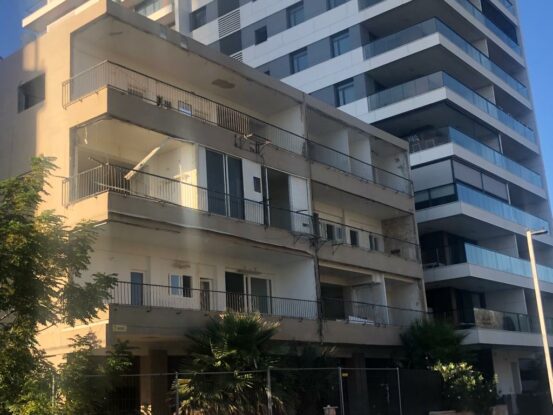Residents of an apartment building in Ramat Gan were required to evacuate their apartments quickly and lost most of their property. The event once again shone a spotlight on the failures of the state and municipalities on the issue. A report by the State Comptroller found that to date, only 7% of all apartments built before 1980 have been reinforced through TAMA 38, and that nearly 5,000 buildings in the country are defined as dangerous structures
The precarious condition of tens of thousands of residential buildings in Israel returned to public awareness last week, following the evacuation of a residential building in Ramat Gan on the orders of city engineer Sigal Horesh. The order was given after an engineering report made at the site showed that two of the building’s supporting pillars were completely cut off and no longer supporting the building. Following the eviction order, the occupants of the building were forced to evacuate quickly, leaving behind most of their belongings. Two days later, the building was deliberately demolished.
This sad story has once again brought to the surface the public debate about Israel’s unpreparedness in the event of an earthquake. The incident was reminiscent of a similar incident that occurred only last September in Holon, when only a day after the evacuation of a building on the orders of the fire department, the building collapsed on its own. The public outrage then led to the feeling that the state together with the local authorities would buckle up with the aim of massively strengthening and encouraging urban renewal in older buildings, but this did not happen.
It should be noted that the building in Ramat Gan has been in the process of pinui-binui evacuation and construction for over a decade, and even received a “conditional building permit” a year ago. The implication of such a permit is that the developer must continue to receive the approvals of various entities such as the Electric Company, the fire department, and more in order to be able to start executing the project. However, in this case, the eviction order preceded that. Following the incident, the Mayor of Ramat Gan, Carmel Shama Hacohen, pointed the finger of blame at the owners of the apartments in the building, saying that as long as the renewal project was not carried out, it was their responsibility to ensure the reliability of the building, since it is privately-owned property. It was also learned that last November the Ramat Gan Municipality even issued a “dangerous structure” alert for the building, which includes a demand to carry out a series of engineering operations, which apparently have not been carried out since then.
610,000 apartments in danger
The near-collapse incident in Ramat Gan occurred exactly two weeks after an audit report was published by the State Comptroller’s Office, Matanyahu Engelman, on local government, in which one of the main points was the neglect of dangerous structures. Following the incident, Engelman issued a statement stating that the evacuation of the building in Ramat Gan, which is in danger of collapse, is part of a broad phenomenon that the audit report referred to.
According to the published report, Israel currently has 610,000 housing units built before 1980 that have not yet been strengthened and therefore may endanger human life. Of all the apartments built before 1980, only 7% were granted a building permit for reinforcement in the framework of TAMA 38 projects until 2020. It was also found that in Israel there are currently 4,840 structures that have been designated as dangerous structures by the authorities that examined them.
Other worrisome findings from the report are that 19% of local authorities do not have any bylaws for handling hazardous structures, 77% of authorities have never mapped or surveyed their territory to find potentially dangerous structures, and 90% of the authorities have never discussed hazardous structures at their council meetings.
The Comptroller also criticized the government’s performance on the issue: “The Ministries of Housing and Interior have not defined criteria for declaring and handling a dangerous structure and have not established training for personnel dealing with hazardous structures. The ministries also did not collect data on the structures that have already been declared dangerous by the local authorities.” On the Ministry of Education, he said that it “set safety requirements but does not require the stability of school buildings and kindergartens.”
According to the State Comptroller, “92.5% of the authorities do not help with loans for the renovation of a collapsed building – we note that the insurance companies also reject the insurance claims in the event of a collapse, as happened in the case of the building in Holon with AIG. The Ministries of Housing and Social Affairs do not have assistance programs for residents who have been forced to vacate their homes, nor does the Ministry of the Interior instruct the local authorities to help the evacuees. The Comptroller recommended that the inter-ministerial team established following the collapse of the building in Holon take action to “regulate the treatment of dangerous structures and to act to reduce the gaps that have been discovered in the local authorities.”
.




